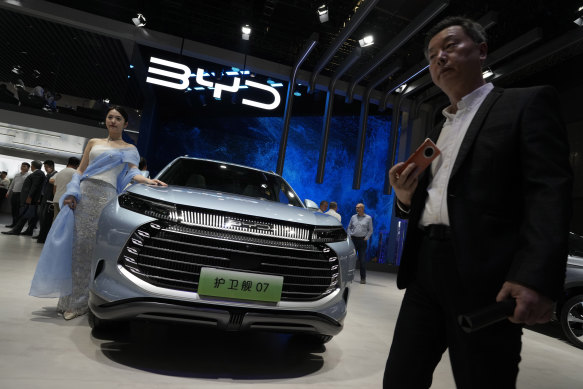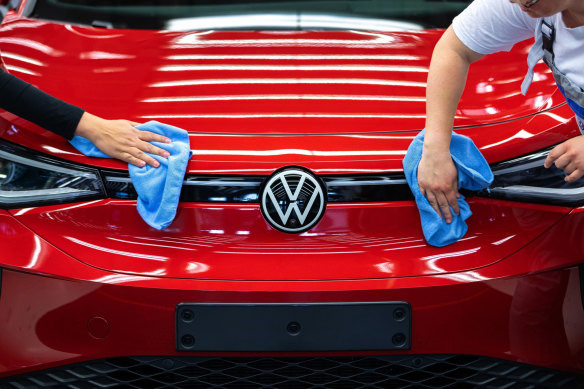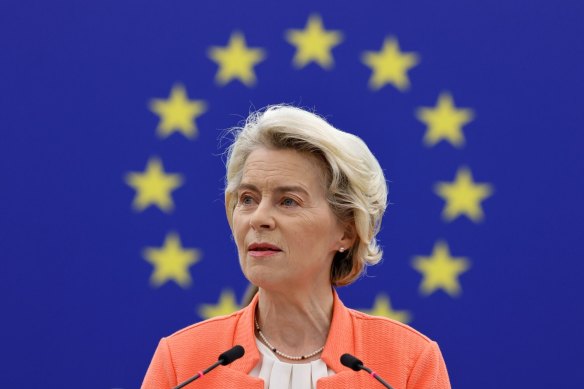This was published 1 year ago
Opinion
How China sparked chaos in the world of cars
Stephen Bartholomeusz
Senior business columnistThe most transformative development in the auto industry’s history since Henry Ford pioneered mass production more than a century ago is threatening both the automotive establishment and its workers and causing angst on both sides of the Atlantic.
The European Commission last week announced an investigation into China’s electric vehicle subsidies. The commission’s president Ursula von der Leyen said the global auto industry was being overrun by cheap Chinese vehicles with prices that are being kept “artificially low by huge state subsidies”.

Chinese brands like BYD are making inroads in global markets.Credit: AP
In the US the United Auto Workers Union (UAW) launched three strikes on Friday in pursuit of a claim for a 36 per cent increase in wages over the next four years as the union tries to defend the high-paid jobs in the legacy industry from a transition to electric vehicles (EVs) that requires fewer and less well-paid workers because there are fewer moving parts.
Most new EV plants in the US are in non-unionised plants in states offering tax incentives, threatening Detroit’s dominance of the industry and the UAW’s members.
The Europeans, Americans, Japanese and South Koreans are handicapped in the race to an EV-dominated future because of the dominance of internal combustion-powered vehicles in their markets.
They make money from their traditional operations but are losing money in their fledgling EV businesses. Ford, for instance, has said its EV business will lose $US4.5 billion ($7 billion) this year.
China, by contrast, is set to dominate the global battery-powered EV industry because more than a decade ago – after realising it had no material competitive advantage in vehicles powered either by internal combustion engines or in the hybrid sector where the Japanese manufacturers led developments – it targeted EVs.
It was a centrally-driven strategy, rolled out in 2009, that deployed subsidies for demand, supply and funding of the sector.
Beijing provided generous subsidies and tax incentives for purchases of EVs, particularly for taxi fleets, bus fleets and for central and local government agencies but also for consumers in a program that was supposed to be tapered and ultimately phased out by 2021. Local governments and state-owned banks also provided support.

Volkswagen and other traditional auto powerhouses are under threat.Credit: Bloomberg
For some manufacturers, by the middle of the last decade the subsidies represented more than half their sales revenue, although that proportion has dropped to single-digit percentages as subsidies have tapered and EV sales exploded.
The pandemic led to subsidies being extended until the end of this year but the spluttering of China’s economy this year resulted in them being extended again following a mid-year announcement that tax waivers for purchases of EVs and hybrids would remain in place until the end of 2025 and then halved in 2026-27 before the incentives are withdrawn.
The decision to pursue EVs was not purely opportunistic. Beijing saw the potential to reduce its carbon emissions through the displacement of the legacy fleet of vehicles and also recognised the potential to leverage its dominance of the supply chain for batteries, which constitute about 40 per cent of an EV’s costs.
The strategy, which extended the incentives to foreign manufacturers with plants within China, has been extraordinarily successful.
Last year nearly 7 million EVs were sold in China – almost nine times the number sold in the US – in a market where locally-owned auto companies are increasingly displacing and dominating foreign brands.
They are also making inroads, with brands like BYD, MG and Polestar, within the international market.
While China-manufacturers vehicles account for only about three per cent of the total market, about 15 per cent of sales in the battery-powered EV market in Europe this year have been generated by China-built vehicles, with the SAIC Motor-owned MG brand accounting for about 6 percentage points and EVs from Tesla’s Chinese plants about 4 percentage points.
The one big market where Chinese-manufactured EVs haven’t gained a foothold is the US, thanks to the 27.5 per cent tariff that Donald Trump slapped on Chinese auto imports, which more than wiped out the estimated 20 per cent or so cost advantage – mainly from lower labour costs – Chinese manufacturers have over their Western competitors.
Europe, with its mandated targets for carbon emissions reductions and a commitment to end sales of gasoline and diesel-powered vehicles by 2035, is by far the most attractive market for the Chinese companies.
It also helps at the margin that tariffs are weighted in China’s favour. Cars exported from Europe to China face a 15 per cent tariff rate. Those going in the other direction are levied only 10 per cent.
If China is able to dominate global EV production it will transform industrial landscapes across the world, given the significance of auto manufacturing within economies and, because of the advanced engineering capabilities it develops, across industry sectors.
The German export powerhouses – Volkswagen, BMW, Mercedes and Audi – have major conventional and EV manufacturing facilities in China but the slowing economic activity amid weak consumer confidence has, despite the extension of the incentives to purchase EVs, created substantial excess capacity and ignited a price war (which Tesla has been aggressively participating in).
The European economies are also struggling and, with the cheaper Chinese brands making accelerating inroads, there is real concern about the future of the auto sector in Europe. The idea of a future where Germany imports its Volkswagens or BMWs from China, unsurprisingly, isn’t appealing to German policymakers or auto unions.
The German manufacturers, however, have such large investments in China that they are unsettled by the EC’s announcement of the investigating of China’s EV subsidies, fearing China – which labelled the move protectionist – will retaliate.
China’s EVs and their batteries are technically sophisticated – they are out-competing most of the major Western brands in electronics and software – while the government-promoted and incentivised take-up of EVs means their EV sector is growing within the world’s largest consumer market.

European Commission president Ursula von der Leyen says the global auto industry was being overrun by cheap Chinese vehicles.Credit: Bloomberg
Without legacy operations and profits to protect and dominance of the battery supply chain, there is the potential for China to replicate the similar path it took to dominance of the global solar sector, an industry where Europe, as a first-mover in response to climate change, once was an industry leader. It isn’t surprising that references to that experience have cropped up in European discussions.
Joe Biden’s Inflation Reduction Act, enacted last year, contains substantial incentives to build and buy EVs (a point of some irritation for Europeans) but the US badly lags China, which claims to be as much as five years ahead of the rest of the world in terms of EV and battery technologies.
If China is able to dominate global EV production it will transform industrial landscapes across the world, given the significance of auto manufacturing within economies and, because of the advanced engineering capabilities it develops, across industry sectors.
Whether it is another bout of protectionism, or more subsidies of their own, or both, other auto manufacturing centres like the US, Europe, Japan and South Korea and their workforces may need more help from policymakers to survive.
The Business Briefing newsletter delivers major stories, exclusive coverage and expert opinion. Sign up to get it every weekday morning.